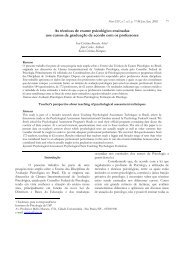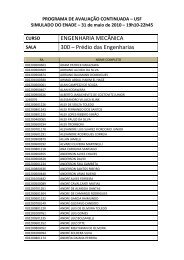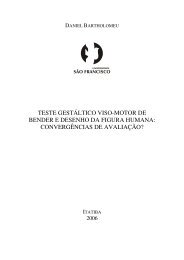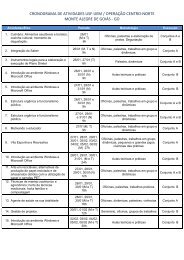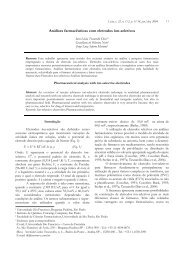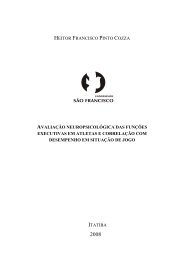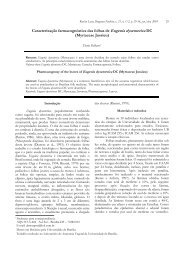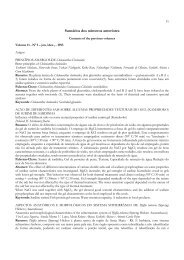Atividade antimicrobiana de Bixa orellana L. (Urucum)
Atividade antimicrobiana de Bixa orellana L. (Urucum)
Atividade antimicrobiana de Bixa orellana L. (Urucum)
Create successful ePaper yourself
Turn your PDF publications into a flip-book with our unique Google optimized e-Paper software.
Revista Lecta, Bragança Paulista, v. 21, n. 1/2, p. 47-54, jan./<strong>de</strong>z. 2003 47<br />
<strong>Ativida<strong>de</strong></strong> <strong>antimicrobiana</strong> <strong>de</strong> <strong>Bixa</strong> <strong>orellana</strong> L. (<strong>Urucum</strong>)<br />
Ana Marina Silveira Pinto Coelho 1<br />
Geraldo Alves da Silva 2<br />
Olivina Maria Carneiro Vieira 2<br />
Jorge Kleber Chavasco 3<br />
Resumo: Realizou-se o estudo da ativida<strong>de</strong> <strong>antimicrobiana</strong> <strong>de</strong> tinturas <strong>de</strong> <strong>Bixa</strong> <strong>orellana</strong> L., conhecida<br />
popularmente como “urucum”. As tinturas foram testadas pelo método <strong>de</strong> difusão em ágar e apresentaram<br />
ativida<strong>de</strong> antibacteriana, mas foram inativas sobre as cepas <strong>de</strong> Cryptococcus neoformans e Candida albicans. Verificou-se,<br />
por triagem fitoquímica, a presença <strong>de</strong> saponinas, flavonói<strong>de</strong>s, taninos, alcalói<strong>de</strong>s e esterói<strong>de</strong>s.<br />
Palavras-chave: <strong>Bixa</strong> <strong>orellana</strong>; <strong>Urucum</strong>; Annatto; <strong>Ativida<strong>de</strong></strong> <strong>antimicrobiana</strong>.<br />
Antimicrobial activity from <strong>Bixa</strong> <strong>orellana</strong> L. (<strong>Urucum</strong>)<br />
Abstract: The antimicrobial activity of the tinctures of <strong>Bixa</strong> <strong>orellana</strong> L., commonly known as “urucum”, was<br />
studied. These tinctures were tested by diffusion method in agar and showed antimicrobial activity, but were<br />
inactive on the stumps of Cryptococcus neoformans e Candida albicans. The phytochemical screening indicated the<br />
presence of saponins, flavonoids, tannins, alkaloids and steroids.<br />
Keywords: <strong>Bixa</strong> <strong>orellana</strong>; <strong>Urucum</strong>; Annatto; Antimicrobial activity.<br />
Introdução<br />
A espécie medicinal <strong>Bixa</strong> <strong>orellana</strong> L. pertence à<br />
família das <strong>Bixa</strong>ceae, sendo popularmente conhecida como<br />
urucu, urucum, açafroa, açafroeira-da-terra, roucou, bija,<br />
achiote, annatto, conforme a região (Rodrigues et al.,<br />
1988). Trata-se <strong>de</strong> um arbusto gran<strong>de</strong> ou árvore pequena,<br />
com 3 a 5 m <strong>de</strong> altura e <strong>de</strong> copa bem <strong>de</strong>senvolvida. As<br />
folhas são simples, glabras, medindo 8 a 11 cm <strong>de</strong><br />
comprimento. As flores são levemente rosas, dispostas<br />
em panículas. O fruto é uma cápsula <strong>de</strong>iscente ovói<strong>de</strong>,<br />
com dois ou três carpelos, cobertos por espinhos. É<br />
uma espécie originária da América tropical, incluindo a<br />
Amazônia brasileira (Lorenzi & Matos, 2002).<br />
Além da utilização na culinária do colorau, um<br />
pigmento extraído das sementes, o urucum é empregado<br />
na medicina popular como medicamento para doenças<br />
coronarianas, afecções do estômago e intestino, afecções<br />
respiratórias, queimaduras, e como afrodisíaco. As<br />
folhas combatem as afecções renais e febre (Lorenzi &<br />
Matos, 2002; Teske & Trentini, 1994).<br />
Segundo estudos <strong>de</strong> Cáceres et al. (1990, 1995)<br />
sobre a ativida<strong>de</strong> <strong>antimicrobiana</strong> <strong>de</strong> B. <strong>orellana</strong>, os extratos<br />
obtidos do fruto, da raiz e da folha apresentaram<br />
resultados positivos, enquanto o extrato das sementes<br />
não apresentou esta ativida<strong>de</strong>. Huhtanen (1980) estudou<br />
a tintura do fruto frente ao Clostridium botulinum,<br />
<strong>de</strong>terminando o valor da MIC em 31 ppm.<br />
Segundo Lorenzi e Matos (2002), o estudo<br />
fitoquímico revelou a existência, na folha, <strong>de</strong> um óleo<br />
volátil contendo mono e sesquiterpenos, entre os quais<br />
<strong>de</strong>staca-se ishwarano e vários flavonói<strong>de</strong>s. Na semente<br />
ocorre um óleo essencial rico em all-E-geranilgeraniol,<br />
monoterpenos e sesquiterpenos oxigenados, além <strong>de</strong><br />
carotenói<strong>de</strong>s bixina e norbixina, responsáveis pela cor, e<br />
alfa e beta-caroteno em teores mais baixos. Mercadante<br />
et al. (1996, 1997a e b e 1999) isolaram e elucidaram<br />
vários carotenói<strong>de</strong>s menores presentes nas sementes.<br />
Os estudos realizados para verificar a ativida<strong>de</strong><br />
<strong>antimicrobiana</strong> <strong>de</strong> plantas têm sua importância cada vez<br />
maior, tendo em vista a resistência crescente dos microrganismos<br />
aos antibióticos hoje comercializados (Cunha<br />
et al., 1995). Na tentativa <strong>de</strong> aumentar o conhecimento<br />
sobre plantas medicinais com potencial antimicrobiano,<br />
<strong>de</strong>spertou-se o interesse em avaliar as possíveis<br />
proprieda<strong>de</strong>s do urucum (<strong>Bixa</strong> <strong>orellana</strong> L.), pesquisando<br />
as tinturas <strong>de</strong> órgãos frescos e secos do vegetal.<br />
Material e métodos<br />
Coleta e preparo do material botânico<br />
Foram coletadas amostras <strong>de</strong> caule, flor, folha,<br />
fruto e raiz <strong>de</strong> <strong>de</strong>z exemplares adultos <strong>de</strong> B. <strong>orellana</strong>, no<br />
período <strong>de</strong> abril a junho <strong>de</strong> 1998, no Sítio da Lagoa, em<br />
1 Departamento <strong>de</strong> Ciências Biológicas da Escola <strong>de</strong> Farmácia e Odontologia <strong>de</strong> Alfenas, Centro Universitário Fe<strong>de</strong>ral<br />
(Efoa/Ceufe) – Alfenas-MG – 37130-000<br />
2 Departamento <strong>de</strong> Farmácia da Efoa/Ceufe.<br />
3 Universida<strong>de</strong> <strong>de</strong> Alfenas (Unifenas), Universida<strong>de</strong> do Vale do Rio Ver<strong>de</strong> (Unincor) e Efoa/Ceufe.
48<br />
Ana Marina Silveira Pinto Coelho, Geraldo Alves da Silva, Olivina Maria Carneiro Vieira, Jorge Kleber Chavasco<br />
Alfenas, MG. O material foi i<strong>de</strong>ntificado e a exsicata<br />
<strong>de</strong>positada no Herbário da Universida<strong>de</strong> Fe<strong>de</strong>ral <strong>de</strong><br />
Lavras sob o número 15.817.<br />
Preparo das tinturas<br />
As tinturas <strong>de</strong> órgãos frescos e secos foram<br />
obtidas conforme técnica <strong>de</strong>scrita por Cáceres et al.<br />
(1990, 1995), sendo pesados 200 g <strong>de</strong> cada órgão e<br />
triturados em liquidificador com 800 mL <strong>de</strong> etanol 70°<br />
GL. Posteriormente, foram concentradas em evaporador<br />
rotatório e filtradas através <strong>de</strong> filtro Millipore ®. As<br />
tinturas foram neutralizadas com hidróxido <strong>de</strong> amônia e<br />
a seguir divididas em dois grupos, refrigerados e<br />
liofilizados (somente <strong>de</strong> órgãos frescos), conforme os<br />
processos <strong>de</strong> conservação utilizados.<br />
Determinação da ativida<strong>de</strong> <strong>antimicrobiana</strong><br />
Os microrganismos empregados (bactérias e<br />
leveduras) foram isolados <strong>de</strong> amostras clínicas e mantidos<br />
no Laboratório <strong>de</strong> Microbiologia e Imunologia da Escola<br />
<strong>de</strong> Farmácia e Odontologia <strong>de</strong> Alfenas (Efoa/Ceufe).<br />
Foram utilizados 2 fungos (Cryptococcus neoformans e<br />
Candida albicans) e 12 bactérias (Bacillus sp, Bacillus subtilis,<br />
Chromobacterium violaceum, Enterococcus faecalis, Enterobacter<br />
aerogenes, Escherichia coli, Proteus sp, Pseudomonas aeruginosa,<br />
Salmonella sp, Salmonella enteritidis, Serratia marcescens, e<br />
Staphylococcus aureus).<br />
As tinturas foram submetidas à avaliação da<br />
ativida<strong>de</strong> <strong>antimicrobiana</strong> pela adaptação da técnica <strong>de</strong><br />
difusão em ágar <strong>de</strong> Bauer et al. (1966). As suspensões<br />
microbianas utilizadas nos testes foram ajustadas para<br />
turvação, equivalente ao tubo 1 da Escala <strong>de</strong> Mac Farland<br />
(Bier, 1980). As culturas foram transferidas para o meio<br />
<strong>de</strong> cultura com “swabs”, sendo aplicados 30 µL <strong>de</strong> tintura<br />
por cavida<strong>de</strong> feita com tubo <strong>de</strong> 4 mm <strong>de</strong> diâmetro.<br />
As tinturas liofilizadas foram ressuspendidas em água<br />
<strong>de</strong>stilada estéril com a meta<strong>de</strong> do volume original.<br />
Para a maioria das bactérias foi empregado<br />
meio <strong>de</strong> ágar Nutriente, para Enterococcus faecalis, ágar<br />
Sangue e para os fungos ágar Sabouraud. As amostras<br />
das tinturas foram <strong>de</strong>positadas nas cavida<strong>de</strong>s, do meio<br />
<strong>de</strong> cultura (6 por placa), correspon<strong>de</strong>ntes às 6 tinturas<br />
<strong>de</strong> órgãos da planta. Após incubação a 37ºC, por 24<br />
horas, anotou-se o diâmetro do halo <strong>de</strong> inibição <strong>de</strong><br />
crescimento, com auxílio <strong>de</strong> paquímetro. Foram<br />
consi<strong>de</strong>radas com ativida<strong>de</strong> <strong>antimicrobiana</strong> as tinturas<br />
que produziram halos <strong>de</strong> inibição. Cada experimento foi<br />
realizado em réplicas <strong>de</strong> cinco.<br />
Triagem fitoquímica<br />
Na triagem fitoquímica foram pesquisados os<br />
seguintes grupos <strong>de</strong> princípios ativos: flavonói<strong>de</strong>s, pela<br />
técnica <strong>de</strong> reação <strong>de</strong> Shinoda e reação com hidróxidos<br />
alcalinos; taninos, pelo método <strong>de</strong> precipitação com sais<br />
<strong>de</strong> ferro, acetato <strong>de</strong> chumbo, alcalói<strong>de</strong>s, gelatina e acetato<br />
<strong>de</strong> cobre; alcalói<strong>de</strong>s, pelo método <strong>de</strong> precipitação com<br />
os reativos <strong>de</strong> Mayer, Bertrand, Dragendorff e<br />
Bouchardat; esterói<strong>de</strong>s, pela reação <strong>de</strong> Liebermann-<br />
Burchard; saponinas, pela agitação do extrato aquoso<br />
com formação <strong>de</strong> espuma persistente; cumarinas,<br />
utilizando a técnica com metanol (Costa, 1982).<br />
Análise estatística<br />
A análise estatística dos resultados foi feita pelo<br />
método <strong>de</strong> análise <strong>de</strong> variância – Anova (Vieira, 1991).<br />
Resultados<br />
<strong>Ativida<strong>de</strong></strong> <strong>antimicrobiana</strong><br />
As tabelas e figuras 1, 2 e 3 mostram os<br />
resultados obtidos com a utilização <strong>de</strong> tinturas <strong>de</strong><br />
órgãos da planta B. <strong>orellana</strong> diante <strong>de</strong> doze amostras<br />
bacterianas e duas fúngicas. Po<strong>de</strong>-se observar que as<br />
amostras fúngicas apresentaram resistência.<br />
Revista Lecta, Bragança Paulista, v. 21, n. 1/2, p. 47-54, jan./<strong>de</strong>z. 2003
Revista Lecta, Bragança Paulista, v. 21, n. 1/2, p. 47-54, jan./<strong>de</strong>z. 2003<br />
<strong>Ativida<strong>de</strong></strong> <strong>antimicrobiana</strong> <strong>de</strong> <strong>Bixa</strong> <strong>orellana</strong> L. (<strong>Urucum</strong>)<br />
TABELA 1 – Avaliação da ativida<strong>de</strong> <strong>antimicrobiana</strong> in vitro <strong>de</strong> tinturas <strong>de</strong> órgãos frescos <strong>de</strong> B. <strong>orellana</strong> L., ante 14<br />
espécies microbianas, utilizando-se o método da difusão em ágar. Determinação dos halos <strong>de</strong><br />
inibição* (mm)<br />
TABLE 1 – Evaluation of the antimicrobial activity in vitro of tinctures of fresh organ from B. <strong>orellana</strong> L., employing<br />
14 microbial stumps by diffusion method in agar. Determination of inhibition halos* (mm)<br />
TINTURAS DE ÓRGÃOS FRESCOS / HALO DE INIBIÇÃO*(mm)<br />
Microorganismos Caule Flor Folha Fruto Fruto Ver<strong>de</strong> Raiz<br />
Cryptococcus neoformans - - - - - -<br />
Candida albicans - - - - - -<br />
Bacillus sp 7,8± 1,3 5,1±0,4 9,7±1,4 - 8,6±2,3 7,9±0,4<br />
Bacillus subtilis 10,6± 2,0 9,0± 1,1 11,4±0,8 - 10,3±1,2 10,5±1,1<br />
Chromobacterium violaceum 7,1±2,5 - 8,3±1,5 - 6,5±1,0 6,0±1,2<br />
Enterococcus faecalis - - 8,8±1,8 - 8,0±2,0 7,1±2,7<br />
Enterobacter aerogenes 10,1±1,3 7,6± 1,3 12,5±1,2 - 11,3±2,4 9,7±0,3<br />
Escherichia coli - - 8,6±1,2 - - -<br />
Proteus sp 7,7±2,0 6,9±1,2 10,0±2,0 - 9,1±1,4 8,1± 1,7<br />
Pseudomonas aeruginosa 7,6±2,7 4,6±1,7 11,1±1,7 - 8,5± 0,9 6,8±0,7<br />
Salmonella sp 6,2±1,2 5,3± 0,7 10,1±1,1 - 9,0±2,5 9,1±4,5<br />
Salmonella enteritidis 6,5±1,6 5,6±2,2 10,0±1,5 - 7,3±0,7 6,3±1,1<br />
Serratia marcescens 6,8±1,8 5,6±1,8 8,5±1,2 - 6,5±0,5 7,5±1,5<br />
Staphylococcus aureus<br />
* Valor médio <strong>de</strong> 5 réplicas.<br />
10,9±4,1 7,5±1,2 15,0± 4,5 - 10,5±2,5 12,4±4,9<br />
Halo <strong>de</strong> Inibição (mm)<br />
16<br />
14<br />
12<br />
10<br />
8<br />
6<br />
4<br />
2<br />
0<br />
<br />
<br />
<br />
<br />
<br />
<br />
<br />
<br />
<br />
<br />
<br />
<br />
<br />
<br />
<br />
<br />
<br />
<br />
<br />
<br />
<br />
<br />
<br />
<br />
<br />
<br />
<br />
<br />
<br />
<br />
<br />
<br />
<br />
<br />
<br />
<br />
<br />
<br />
<br />
<br />
<br />
<br />
<br />
<br />
<br />
<br />
<br />
<br />
<br />
<br />
<br />
<br />
<br />
<br />
<br />
<br />
<br />
<br />
<br />
<br />
<br />
<br />
<br />
<br />
<br />
<br />
<br />
<br />
<br />
<br />
<br />
<br />
<br />
<br />
<br />
<br />
<br />
<br />
<br />
<br />
<br />
<br />
<br />
<br />
<br />
<br />
<br />
<br />
<br />
<br />
<br />
<br />
<br />
<br />
<br />
<br />
<br />
<br />
<br />
<br />
<br />
<br />
<br />
<br />
<br />
<br />
<br />
<br />
<br />
<br />
<br />
<br />
<br />
<br />
<br />
<br />
<br />
<br />
<br />
<br />
<br />
<br />
<br />
<br />
<br />
<br />
<br />
<br />
<br />
<br />
<br />
<br />
<br />
<br />
<br />
<br />
<br />
<br />
<br />
<br />
<br />
<br />
<br />
<br />
<br />
<br />
<br />
<br />
<br />
<br />
<br />
<br />
<br />
<br />
<br />
<br />
<br />
<br />
<br />
<br />
<br />
<br />
<br />
<br />
<br />
<br />
<br />
<br />
<br />
<br />
<br />
<br />
<br />
<br />
<br />
<br />
<br />
<br />
<br />
<br />
<br />
<br />
<br />
<br />
<br />
<br />
<br />
<br />
<br />
<br />
<br />
<br />
<br />
<br />
<br />
<br />
<br />
<br />
<br />
<br />
<br />
<br />
<br />
<br />
<br />
<br />
<br />
<br />
<br />
<br />
<br />
<br />
<br />
<br />
<br />
<br />
<br />
<br />
<br />
<br />
<br />
<br />
<br />
<br />
<br />
<br />
<br />
<br />
<br />
<br />
<br />
<br />
<br />
<br />
<br />
<br />
<br />
<br />
<br />
<br />
<br />
<br />
<br />
<br />
<br />
<br />
<br />
<br />
<br />
<br />
<br />
<br />
<br />
<br />
<br />
<br />
<br />
<br />
<br />
<br />
<br />
<br />
<br />
<br />
<br />
<br />
<br />
<br />
<br />
<br />
<br />
<br />
<br />
<br />
<br />
<br />
<br />
<br />
<br />
( -) Ausência <strong>de</strong> halo <strong>de</strong> inibição.<br />
CAULE FLOR FOLHA FRUTO FRUTO VERDE RAIZ<br />
Tinturas <strong>de</strong> Órgãos Frescos<br />
<br />
Bacillus sp<br />
<br />
Cryptococcus neoformans Candida albicans<br />
Bacillus subtilis Chromobacterium violaceum Enterococcus faecalis<br />
<br />
<br />
Enterobacter aerogenes<br />
Escherichia <br />
coli<br />
Pseudomonas aeruginosa<br />
Salmonella sp<br />
Serratia marcescens Staphylococcus aureus<br />
<br />
Proteus sp<br />
<br />
Salmonella enteritidis<br />
FIGURA 1 – Avaliação da ativida<strong>de</strong> <strong>antimicrobiana</strong> in vitro <strong>de</strong> tinturas <strong>de</strong> órgãos frescos <strong>de</strong> B. <strong>orellana</strong> L., ante 14<br />
espécies microbianas, utilizando-se o método da difusão em ágar. Determinação dos halos <strong>de</strong><br />
inibição* (mm)<br />
FIGURE 1 – Evaluation of the antimicrobial activity in vitro of tinctures of fresh organ from B. <strong>orellana</strong> L., employing<br />
14 microbial stumps by diffusion method in agar. Determination of inhibition halos* (mm)<br />
49
50<br />
Ana Marina Silveira Pinto Coelho, Geraldo Alves da Silva, Olivina Maria Carneiro Vieira, Jorge Kleber Chavasco<br />
TABELA 2 – Avaliação da ativida<strong>de</strong> <strong>antimicrobiana</strong> in vitro <strong>de</strong> tinturas liofilizadas <strong>de</strong> B. <strong>orellana</strong> L., ante 14 espécies<br />
microbianas, utilizando-se o método da difusão em ágar. Determinação dos halos <strong>de</strong> inibição* (mm)<br />
TABLE 2 – Evaluation of the antimicrobial activity in vitro of lyophilized tinctures from B. <strong>orellana</strong> L., employing<br />
14 microbial stumps by diffusion method in agar. Determination of inhibition halos* (mm)<br />
TINTURAS LIOFILIZADAS / HALOS DE INIBIÇÃO*(mm)<br />
Microorganismos Caule Flor Folha Fruto Fruto Ver<strong>de</strong> Raiz<br />
Cryptococcus neoformans - - - - - -<br />
Candida albicans - - - - - -<br />
Bacillus sp 8,5±1,2 8,4± 2,4 12,6±1,0 - 9,9±1,8 10,2±1,5<br />
Bacillus subtilis 8,8±1,17 8,8±1,4 12,6±1,0 - 10,1±0,6 10,4±0,3<br />
Chromobacterium violaceum 10,0±2,2 12,6±1,9 14,0±2,0 - 12,8± ±1,4 10,8±1,9<br />
Enterococcus faecalis 7,7±1,3 7,2±1,7 11,2±2,2 - 7,4± ±1,0 8,0±1,1<br />
Enterobacter aerogenes 8,4±1,6 9,0±0,6 14,9±0,8 - 11,6±1,0 11,3±0,8<br />
Escherichia coli 10,0±1,9 10,0±2,7 12,2±2,9 - 8,4±0,5 9,4±1,1<br />
Proteus sp 10,1±1,7 10,6±1,7 14,0±1,1 - 10,6±1,7 10,4±1,9<br />
Pseudomonas aeruginosa 10,6±3,6 12,2±2,1 15,8±1,9 - 12,8±1,8 11,4±1,2<br />
Salmonella sp 10,2±2,2 11,4±1,6 15,7±1,9 - 12,6±1,6 12,2±1,1<br />
Salmonella enteritidis 8,6±2,1 10,0±2,5 13,6±2,2 - 10,8±1,1 9,8±1,1<br />
Serratia marcescens 10,2±2,1 11,2±2,2 15,4±2,2 - 12,6±1,7 11,4±1,0<br />
Staphylococcus aureus<br />
* Valor médio <strong>de</strong> 5 réplicas.<br />
( -) Ausência <strong>de</strong> halo <strong>de</strong> inibição.<br />
8,2±1,1 12,3±1,6 11,4±1,3 - 8,8±1,6 8,8±0,9<br />
Halo <strong>de</strong> Inibição (mm)<br />
18<br />
16<br />
14<br />
12<br />
10<br />
8<br />
6<br />
4<br />
2<br />
0<br />
<br />
<br />
<br />
<br />
<br />
<br />
<br />
<br />
<br />
<br />
<br />
<br />
<br />
<br />
<br />
<br />
<br />
<br />
<br />
<br />
<br />
<br />
<br />
<br />
<br />
<br />
<br />
<br />
<br />
<br />
<br />
<br />
<br />
<br />
<br />
<br />
<br />
<br />
<br />
<br />
<br />
<br />
<br />
<br />
<br />
<br />
<br />
<br />
<br />
<br />
<br />
<br />
<br />
<br />
<br />
<br />
<br />
<br />
<br />
<br />
<br />
<br />
<br />
<br />
<br />
<br />
<br />
<br />
<br />
<br />
<br />
<br />
<br />
<br />
<br />
<br />
<br />
<br />
<br />
<br />
<br />
<br />
<br />
<br />
<br />
<br />
<br />
<br />
<br />
<br />
<br />
<br />
<br />
<br />
<br />
<br />
<br />
<br />
<br />
<br />
<br />
<br />
<br />
<br />
<br />
<br />
<br />
<br />
<br />
<br />
<br />
<br />
<br />
<br />
<br />
<br />
<br />
<br />
<br />
<br />
<br />
<br />
<br />
<br />
<br />
<br />
<br />
<br />
<br />
<br />
<br />
<br />
<br />
<br />
<br />
<br />
<br />
<br />
<br />
<br />
<br />
<br />
<br />
<br />
<br />
<br />
<br />
<br />
<br />
<br />
<br />
<br />
<br />
<br />
<br />
<br />
<br />
<br />
<br />
<br />
<br />
<br />
<br />
<br />
<br />
<br />
<br />
<br />
<br />
<br />
<br />
<br />
<br />
<br />
<br />
<br />
<br />
<br />
<br />
<br />
<br />
<br />
<br />
<br />
<br />
<br />
<br />
<br />
<br />
<br />
<br />
<br />
<br />
<br />
<br />
<br />
<br />
<br />
<br />
<br />
<br />
<br />
<br />
<br />
<br />
<br />
<br />
<br />
<br />
<br />
<br />
<br />
<br />
<br />
<br />
<br />
<br />
<br />
<br />
<br />
<br />
<br />
<br />
<br />
<br />
<br />
<br />
<br />
<br />
<br />
<br />
CAULE FLOR FOLHA FRUTO FRUTO VERDE RAIZ<br />
Cryptococcus neoformans Candida albicans<br />
Chromobacterium violaceum<br />
<br />
Enterococcus faecalis<br />
<br />
Proteus sp Pseudomonas<br />
<br />
aeruginosa<br />
Serratia marcescens Staphylococcus aureus<br />
Tinturas Liofilizadas<br />
<br />
Bacillus<br />
sp Bacillus subtilis<br />
Enterobacter aerogenes Escherichia coli<br />
Salmonella sp Salmonella enteritidis<br />
FIGURA 2 – Avaliação da ativida<strong>de</strong> <strong>antimicrobiana</strong> in vitro <strong>de</strong> tinturas liofilizadas <strong>de</strong> B. <strong>orellana</strong> L., ante 14 espécies<br />
microbianas, utilizando-se o método da difusão em ágar. Determinação dos halos <strong>de</strong> inibição* (mm)<br />
FIGURE 2 – Evaluation of the antimicrobial activity in vitro of lyophilized tinctures from B. <strong>orellana</strong> L., employing<br />
14 microbial stumps by diffusion method in agar. Determination of inhibition halos* (mm)<br />
Revista Lecta, Bragança Paulista, v. 21, n. 1/2, p. 47-54, jan./<strong>de</strong>z. 2003
Revista Lecta, Bragança Paulista, v. 21, n. 1/2, p. 47-54, jan./<strong>de</strong>z. 2003<br />
<strong>Ativida<strong>de</strong></strong> <strong>antimicrobiana</strong> <strong>de</strong> <strong>Bixa</strong> <strong>orellana</strong> L. (<strong>Urucum</strong>)<br />
TABELA 3 – Avaliação da ativida<strong>de</strong> <strong>antimicrobiana</strong> in vitro <strong>de</strong> tinturas <strong>de</strong> órgãos secos obtidas <strong>de</strong> B. <strong>orellana</strong> L., ante<br />
14 espécies microbianas, utilizando-se o método da difusão em ágar. Determinação dos halos <strong>de</strong><br />
inibição* (mm)<br />
TABLE 3 – Evaluation of the antimicrobial activity in vitro of tinctures of dry organ from B. <strong>orellana</strong> L., employing<br />
14 microbial stumps by diffusion method in agar. Determination of inhibition halos* (mm)<br />
TINTURAS DE ÓRGÃOS SECOS/HALOS DE INIBIÇÃO * (mm)<br />
Microorganismos Caule Flor Folha Fruto Fruto Ver<strong>de</strong> Raiz<br />
Cryptococcus neoformans – – – – – –<br />
Candida albicans – – – – – –<br />
Bacillus sp 6,0±1,6 10,2±2,1 10,6±0,8 – 9,6±3,3 5,2±0,5<br />
Bacillus subtilis 10,7±3,0 10,6±3,8 10,4±2,0 – 9,4±2,5 5,8±1,7<br />
Chromobacterium violaceum 8,9±2,0 8,4±1,6 11,6±1,3 – 10,0±1,1 7,2±1,1<br />
Enterococcus faecalis – 7,2±2,3 10,0±1,4 – 9,4±1,3 –<br />
Enterobacter aerogenes 8,2±0,8 10,0±1,6 11,3±0,8 – 7,8±0,4 7,1±0,2<br />
Escherichia coli 9,8±0,7 8,6±0,8 12,2±2,3 – 10,8±0,4 7,8±0,7<br />
Proteus sp 9,4±0,8 10,8±1,4 12,2±1,1 – 11,4±1,6 8,0±1,4<br />
Pseudomonas aeruginosa 9,2±2,3 10,6±1,2 12,8±3,0 – 11,6±2,3 9,0±2,8<br />
Salmonella sp 9,9±2,0 10,6±1,0 13,2±0,9 – 10,6±1,2 6,2±1,0<br />
Salmonella enteritidis 8,7±1,5 10,8±0,7 13,0±1,4 – 10,2±2,6 7,2±0,9<br />
Serratia marcescens 7,8±1,1 9,0±0,8 10,8±1,6 – 9,00 ±2,3 5,4±0,8<br />
Staphylococcus aureus 8,8±1,1 11,6±1,7 11,4±1,2 – 11,0±1,7 7,6±1,9<br />
* Valor médio <strong>de</strong> 5 réplicas.<br />
(–) Ausência <strong>de</strong> halo <strong>de</strong> inibição.<br />
Halo <strong>de</strong> Inibição (mm)<br />
14<br />
12<br />
10<br />
8<br />
6<br />
4<br />
2<br />
0<br />
<br />
<br />
<br />
<br />
<br />
<br />
<br />
<br />
<br />
<br />
<br />
<br />
<br />
<br />
<br />
<br />
<br />
<br />
<br />
<br />
<br />
<br />
<br />
<br />
<br />
<br />
<br />
<br />
<br />
<br />
<br />
<br />
<br />
<br />
<br />
<br />
<br />
<br />
<br />
<br />
<br />
<br />
<br />
<br />
<br />
<br />
<br />
<br />
<br />
<br />
<br />
<br />
<br />
<br />
<br />
<br />
<br />
<br />
<br />
<br />
<br />
<br />
<br />
<br />
<br />
<br />
<br />
<br />
<br />
<br />
<br />
<br />
<br />
<br />
<br />
<br />
<br />
<br />
<br />
<br />
<br />
<br />
<br />
<br />
<br />
<br />
<br />
<br />
<br />
<br />
<br />
<br />
<br />
<br />
<br />
<br />
<br />
<br />
<br />
<br />
<br />
<br />
<br />
<br />
<br />
<br />
<br />
<br />
<br />
<br />
<br />
<br />
<br />
<br />
<br />
<br />
<br />
<br />
<br />
<br />
<br />
<br />
<br />
<br />
<br />
<br />
<br />
<br />
<br />
<br />
<br />
<br />
<br />
<br />
<br />
<br />
<br />
<br />
<br />
<br />
<br />
<br />
<br />
<br />
<br />
<br />
<br />
<br />
<br />
<br />
<br />
<br />
<br />
<br />
<br />
<br />
<br />
<br />
<br />
<br />
<br />
<br />
<br />
<br />
<br />
<br />
<br />
<br />
<br />
<br />
<br />
<br />
<br />
<br />
<br />
<br />
<br />
<br />
<br />
<br />
<br />
<br />
<br />
<br />
<br />
<br />
<br />
<br />
<br />
<br />
<br />
<br />
<br />
<br />
<br />
<br />
<br />
<br />
<br />
<br />
<br />
<br />
<br />
<br />
<br />
<br />
<br />
<br />
<br />
<br />
<br />
<br />
<br />
<br />
<br />
<br />
<br />
<br />
<br />
<br />
<br />
<br />
<br />
<br />
<br />
<br />
<br />
<br />
<br />
<br />
<br />
<br />
<br />
<br />
<br />
<br />
<br />
<br />
<br />
<br />
<br />
<br />
<br />
<br />
<br />
<br />
<br />
<br />
<br />
<br />
<br />
<br />
<br />
<br />
<br />
<br />
<br />
<br />
<br />
<br />
<br />
<br />
<br />
<br />
<br />
<br />
<br />
<br />
<br />
<br />
<br />
<br />
CAULE FLOR FOLHA FRUTO FRUTO VERDE RAIZ<br />
Cryptococcus neoformans Candida albicans<br />
Tinturas <strong>de</strong> Órgãos Secos<br />
<br />
Bacillus sp Bacillus subtilis<br />
<br />
<br />
<br />
Chromobacterium violaceum Enterococcus faecalis Enterobacter aerogenes Escherichia coli<br />
Proteus sp Pseudomonas aeruginosa<br />
Salmonella sp Salmonella enteritidis<br />
Serratia marcescens<br />
Staphylococcus aureus<br />
FIGURA 3 – Avaliação da ativida<strong>de</strong> <strong>antimicrobiana</strong> in vitro <strong>de</strong> tinturas <strong>de</strong> órgãos secos obtidas <strong>de</strong> B. <strong>orellana</strong> L., ante<br />
14 espécies microbianas, utilizando-se o método da difusão em ágar. Determinação dos halos <strong>de</strong><br />
inibição* (mm)<br />
FIGURE 3 – Evaluation of the antimicrobial activity in vitro of tinctures of dry organ from B. <strong>orellana</strong> L., employing<br />
14 microbial stumps by diffusion method in agar. Determination of inhibition halos* (mm)<br />
51
52<br />
Ana Marina Silveira Pinto Coelho, Geraldo Alves da Silva, Olivina Maria Carneiro Vieira, Jorge Kleber Chavasco<br />
Triagem Fitoquímica<br />
Conforme a Tabela 4, verificou-se a presença <strong>de</strong> saponinas, flavonói<strong>de</strong>s, taninos, alcalói<strong>de</strong>s e esterói<strong>de</strong>s.<br />
TABELA 4 – Triagem fitoquímica <strong>de</strong> tinturas <strong>de</strong> B. <strong>orellana</strong> L.<br />
TABLE 4 – Phytochemical screening of the tinctures from B. <strong>orellana</strong> L.<br />
Extratos Saponinas Flavonói<strong>de</strong>s Taninos Alcalói<strong>de</strong>s Esterói<strong>de</strong>s Cumarina<br />
T1 + + + + + -<br />
Caule<br />
T2<br />
T3<br />
+<br />
+<br />
+<br />
+<br />
+<br />
+<br />
+<br />
+<br />
+<br />
+<br />
-<br />
-<br />
T1 + + + + + -<br />
Flor<br />
T2<br />
T3<br />
+<br />
+<br />
+<br />
+<br />
+<br />
+<br />
+<br />
+<br />
+<br />
+<br />
-<br />
-<br />
T1 + + + + + -<br />
Folha<br />
T2<br />
T3<br />
+<br />
+<br />
+<br />
+<br />
+<br />
+<br />
+<br />
+<br />
+<br />
+<br />
-<br />
-<br />
T1 + + + + + -<br />
Fruto<br />
T2<br />
T3<br />
+<br />
+<br />
+<br />
+<br />
+<br />
+<br />
+<br />
+<br />
+<br />
+<br />
-<br />
-<br />
T1 + + + + + -<br />
Fruto Ver<strong>de</strong><br />
T2<br />
T3<br />
+<br />
+<br />
+<br />
+<br />
+<br />
+<br />
+<br />
+<br />
+<br />
+<br />
-<br />
-<br />
T1 + + + + + -<br />
Raiz<br />
T2<br />
T3<br />
+<br />
+<br />
+<br />
+<br />
+<br />
+<br />
+<br />
+<br />
+<br />
+<br />
-<br />
-<br />
T1 – Tintura <strong>de</strong> órgão fresco; T2 – Tintura liofilizada; T3 – Tintura <strong>de</strong> órgão seco.<br />
+ - Presença; − - Ausência.<br />
Discussão<br />
De acordo com os resultados, po<strong>de</strong>mos<br />
verificar que todas as tinturas foram inativas ante as<br />
espécies fúngicas testadas (C. albicans e C. neoformans),<br />
in<strong>de</strong>pen<strong>de</strong>ntemente do órgão e da droga vegetal. Testes<br />
realizados com o extrato hidroalcoólico a 95% <strong>de</strong> folha<br />
<strong>de</strong> B. <strong>orellana</strong> L. (Irobi et al., 1996) mostraram resultados<br />
semelhantes em relação às cepas <strong>de</strong> Candida utilis e<br />
Aspergillus niger. Na literatura consultada não constatamos<br />
nenhum trabalho <strong>de</strong>monstrando ação antifúngica<br />
do urucum.<br />
Comparando as tinturas obtidas <strong>de</strong> folhas<br />
(frescas, droga e liofilizada) <strong>de</strong> B. <strong>orellana</strong>, Tabelas e Figuras<br />
1, 2 e 3, a tintura liofilizada apresentou maior ativida<strong>de</strong><br />
<strong>antimicrobiana</strong> diante das bactérias testadas, exceto a S.<br />
aureus. Maiores halos <strong>de</strong> inibição foram constatados ante<br />
as culturas <strong>de</strong> P. aeruginosa (15,8 mm), Salmonella sp (15,7<br />
mm), S. marcescens (15,4 mm), E. aerogenes (14,94 mm), C.<br />
violaceum (14mm) e Proteus sp (14 mm) (Tabela 2).<br />
Caceres et al. (1995) investigaram 46 plantas,<br />
entre elas <strong>Bixa</strong> <strong>orellana</strong>, quanto à ativida<strong>de</strong>, contra cinco<br />
cepas <strong>de</strong> Neisseria gonorrhoeae através <strong>de</strong> extrato<br />
hidroalcóolico a 50% utilizando a folha e a raiz, e<br />
constataram que somente a folha possui efeito inibidor.<br />
No presente trabalho, as tinturas obtidas <strong>de</strong> folhas e<br />
raiz mostraram ativida<strong>de</strong> <strong>antimicrobiana</strong>, provavelmente<br />
por se tratar <strong>de</strong> testes envolvendo outras bactérias.<br />
Resultados <strong>de</strong> testes realizados com o extrato<br />
hidroalcoólico a 95% (Irobi et al., 1996) obtido <strong>de</strong> folha<br />
fresca do urucum <strong>de</strong>monstraram ativida<strong>de</strong> antibacteriana<br />
somente contra bactérias gram positivas, como B. subtilis e<br />
S. aureus, o que está concordante com os resultados do<br />
presente trabalho, apesar <strong>de</strong> termos <strong>de</strong>tectado também<br />
inibição para bactérias gram negativas. Nos testes realizados<br />
por Irobi et al. (1996), diante <strong>de</strong> bactérias gram negativas<br />
como Escherichia coli e Serratia marcescens, o extrato hidroalcoólico<br />
<strong>de</strong> folha foi inativo. Variações nos resultados<br />
po<strong>de</strong>m ser explicadas por vários fatores como local, época<br />
e período <strong>de</strong> coleta da planta, promovendo diferenças<br />
<strong>de</strong> concentração entre as tinturas (Oliveira, 1991).<br />
Com relação aos <strong>de</strong>mais órgãos, a forma <strong>de</strong><br />
tintura liofilizada obteve maior ativida<strong>de</strong>, em<br />
comparação com as <strong>de</strong>mais tinturas.<br />
As tinturas possuem saponinas, flavonói<strong>de</strong>s,<br />
taninos, alcalói<strong>de</strong>s e esterói<strong>de</strong>s, encontradas na triagem<br />
fitoquímica, o que possivelmente comprova sua ativida<strong>de</strong><br />
<strong>antimicrobiana</strong>. O po<strong>de</strong>r anti-séptico revelado pelos<br />
Revista Lecta, Bragança Paulista, v. 21, n. 1/2, p. 47-54, jan./<strong>de</strong>z. 2003
taninos explica o fato <strong>de</strong>stes impedirem o <strong>de</strong>senvolvimento<br />
<strong>de</strong> microrganismos, associado à própria ação<br />
<strong>de</strong>sinfetante que lhes confere o seu caráter fenólico<br />
(Costa, 1977), provavelmente responsável pela ação<br />
<strong>antimicrobiana</strong> das tinturas.<br />
Cowan (1999) relatou, baseado em trabalhos<br />
encontrados na literatura, que a ativida<strong>de</strong> <strong>antimicrobiana</strong><br />
dos flavonói<strong>de</strong>s, possivelmente, é <strong>de</strong>vida à habilida<strong>de</strong><br />
<strong>de</strong>ste grupo <strong>de</strong> se complexar com proteínas solúveis e<br />
extracelulares e também com a pare<strong>de</strong> <strong>de</strong> células<br />
bacterianas. Muitos flavonói<strong>de</strong>s lipofílicos po<strong>de</strong>m<br />
romper as membranas microbianas. Alguns grupos <strong>de</strong><br />
isoflavonói<strong>de</strong>s possuem proprieda<strong>de</strong>s antifúngicas,<br />
porém nenhuma das tinturas testadas apresentou esta<br />
ativida<strong>de</strong> (Costa, 1977), provavelmente por se encontrar<br />
em concentração baixa ou por pertencer a outros<br />
grupos <strong>de</strong> flavonói<strong>de</strong>s. Com relação aos alcalói<strong>de</strong>s, Iwu<br />
et al. (1999) constataram sua presença, conferindo<br />
ativida<strong>de</strong> antibacteriana em plantas como Cryptolepis<br />
sanguinolenta sobre isolados <strong>de</strong> E. coli, Staphylococcus,<br />
Pseudomonas e Salmonella e Nauclea latifolia sobre isolados<br />
<strong>de</strong> Pseudomonas aeruginosa e Salmonella sp. Neste trabalho<br />
a presença <strong>de</strong> alcalói<strong>de</strong>s foi <strong>de</strong>tectada em todas as tinturas.<br />
Sobre as saponinas, sua ativida<strong>de</strong> <strong>de</strong>pen<strong>de</strong> das suas<br />
estruturas. As saponinas esteroidais mono<strong>de</strong>smosídicas<br />
e várias triterpênicas também com uma única ca<strong>de</strong>ia<br />
glicídica ligada ao C3 possuem proprieda<strong>de</strong>s típicas do<br />
grupo, incluindo as proprieda<strong>de</strong>s hemolíticas, bacterios-<br />
BAUER, A. W. et al. Antibiotic susceptibility testing by<br />
a standardized single disc method. Amer. J. Clin. Path.,<br />
v. 45, p. 493-496, 1966.<br />
BIER, O. Bacteriologia e imunologia. 17. ed. São Paulo:<br />
Melhoramentos, 1980. 1056 p.<br />
CACERES, A. et al. Plants used in Guatemala for the<br />
treatment of gastrointestinal disor<strong>de</strong>rs. 1. Screening of 84<br />
plants against enterobacteria. J. Ethnopharm., Amsterdam,<br />
v. 30, n. 2, p. 55-73, 1990.<br />
CACERES, Armando et al. Antigonorrhoeal activity of<br />
plants used in Guatemala for the treatment of sexually<br />
transmitted diseases. J. Ethnopharm., Amsterdam, v. 48,<br />
n. 2, p. 85-88, 1995.<br />
COSTA, A. F. Farmacognosia. 3. ed. Lisboa: Calouste<br />
Gulbekian, 1977. v. 1, 1031 p.<br />
COSTA, A. F. Isolamento e i<strong>de</strong>ntificação dos constituintes<br />
vegetais. In: Farmacognosia. Lisboa: Fundação<br />
Calouste Gulbenkian, 1982. v. 3, cap. 20, p. 926-962.<br />
COWAN, M. M. Plant products as antimicrobial agents.<br />
Clin. Microbiol. Rev., v. 12, n. 4, p. 564-582, oct. 1999.<br />
Referências bibliográficas<br />
Revista Lecta, Bragança Paulista, v. 21, n. 1/2, p. 47-54, jan./<strong>de</strong>z. 2003<br />
<strong>Ativida<strong>de</strong></strong> <strong>antimicrobiana</strong> <strong>de</strong> <strong>Bixa</strong> <strong>orellana</strong> L. (<strong>Urucum</strong>)<br />
táticas e fungicidas, po<strong>de</strong>ndo explicar a ativida<strong>de</strong><br />
<strong>antimicrobiana</strong> <strong>de</strong>stas tinturas (Costa, 1977). Iwu et al.<br />
(1999) citam em seu trabalho que as saponinas foram<br />
uma das substâncias responsáveis pela ativida<strong>de</strong><br />
antibacteriana contra bactérias gram positivas e gram<br />
negativas encontrada na raiz <strong>de</strong> Nauclea latifolia. Srivastava<br />
et al. (1999), em seu trabalho, citam que vários constituintes<br />
da B. <strong>orellana</strong> foram isolados e i<strong>de</strong>ntificados,<br />
entre os quais incluem os carotenói<strong>de</strong>s, terpenói<strong>de</strong>s,<br />
flavonói<strong>de</strong>s, taninos e traços <strong>de</strong> alcalói<strong>de</strong>s, resultados<br />
estes semelhantes aos nossos. Apesar <strong>de</strong> <strong>de</strong>tectarmos a<br />
presença <strong>de</strong> saponinas, flavonói<strong>de</strong>s, taninos, alcalói<strong>de</strong>s e<br />
esterói<strong>de</strong>s nas tinturas obtidas <strong>de</strong> fruto, as mesmas não<br />
apresentaram ativida<strong>de</strong> <strong>antimicrobiana</strong>, provavelmente<br />
por estar em baixas concentrações, que não foram<br />
avaliadas porque os testes foram apenas qualitativos.<br />
Conclusões<br />
As tinturas <strong>de</strong> B. <strong>orellana</strong> preparadas a partir <strong>de</strong><br />
órgãos e suas drogas foram inativas em face das<br />
leveduras C. albicans e C. neoformans.<br />
As tinturas preparadas <strong>de</strong> folhas e suas drogas<br />
produziram halos <strong>de</strong> inibição em relação a todas as<br />
bactérias.<br />
As tinturas liofilizadas e as tinturas obtidas <strong>de</strong><br />
drogas originadas dos órgãos fruto imaturo e flor<br />
inibiram todas as bactérias.<br />
CUNHA, G. M. <strong>de</strong> A. et al. <strong>Ativida<strong>de</strong></strong> <strong>antimicrobiana</strong><br />
<strong>de</strong> plantas popularmente usadas no Ceará. Rev. Bras.<br />
Farm., Rio <strong>de</strong> Janeiro, v. 76, n. 1, p. 5-6, 1995.<br />
HUHTANEN, C. N. Inhibition of Clostridium botulinum<br />
by spice extracts and aliphatic alcohols. J. Food Protec.,<br />
v. 43, n. 3, p. 195-196, mar. 1980.<br />
IROBI, O. N.; MOO-YOUNG, M.; ANDERSON, W.<br />
A. Antimicrobial activity of annato (<strong>Bixa</strong> <strong>orellana</strong>)<br />
extract. Int. J. Pharmacog., v. 34, n. 2, p. 87-90, 1996.<br />
IWU, M. M.; DUNCAN, A. R.; OKUNJI, C. O.<br />
New antimicrobials of plant origin. Perspectives on new<br />
crops and new uses. 1999. Disponível em:<br />
http://www.hort.purdue.edu/newcrop/proceedings199<br />
9/v4-457.html. Acesso em: 20 jan. 2002.<br />
LORENZI, H.; MATOS, F. J. A. Plantas medicinais no<br />
Brasil: nativas e exóticas. Nova O<strong>de</strong>ssa: Instituto Plantarum,<br />
2002. p. 95-96.<br />
MERCADANTE, A. Z.; STECK, A.; PFANDER, H.<br />
Isolation and structure elucidation of minor carotenoids<br />
from annatto (<strong>Bixa</strong> <strong>orellana</strong> L.) seeds. Phytochemistry, v. 46,<br />
n. 8, p. 1379-1383, 1997a.<br />
53
54<br />
Ana Marina Silveira Pinto Coelho, Geraldo Alves da Silva, Olivina Maria Carneiro Vieira, Jorge Kleber Chavasco<br />
MERCADANTE, A. Z.; STECK, A.; PFANDER, H.<br />
Isolation and i<strong>de</strong>ntification of new apocarotenoids from<br />
annatto (<strong>Bixa</strong> <strong>orellana</strong>) seeds. Journal of Agricultural and<br />
Food Chemistry, v. 45, n. 4, p. 1050-1054, 1997b.<br />
MERCADANTE, A. Z.; STECK, A.; PFANDER, H.<br />
Three minor carotenoids from anatto (<strong>Bixa</strong> <strong>orellana</strong>)<br />
seeds. Phytochemistry, v. 52, p. 135-139, 1999.<br />
MERCADANTE, A. Z.; STECK, A.; RODRIGUEZ-<br />
AMAYA, D.; PFANDER, H.; BRITTON, G. Isolation<br />
of methyl-9’Z-apo-6’-lycopenoate from <strong>Bixa</strong> <strong>orellana</strong>.<br />
Phytochemistry, v. 41, n. 4, p. 1201-1203, 1996.<br />
OLIVEIRA, F.; AKISUE, G.; AKISUE, M. K. Análise<br />
<strong>de</strong> drogas: Sementes. In: Farmacognosia. Rio <strong>de</strong> Janeiro:<br />
Atheneu, 1991. cap. 7, p. 234-236.<br />
RODRIGUES, L. A.; FRACASSO, J. F.; YASHUDA,<br />
Y. The hipotensive action of the extracts from seeds of<br />
<strong>Bixa</strong> <strong>orellana</strong> L. Rev. Ciênc. Farm., São Paulo, v. 10, p. 41-<br />
44, 1988.<br />
SRIVASTAVA, A. et al. Chemistry, pharmacology and<br />
uses of <strong>Bixa</strong> <strong>orellana</strong> – a review. J. Med. Arom. Plant Sci.,<br />
v. 21, n. 4, p. 1145-1154, 1999.<br />
TESKE, M.; TRENTINI, A. M. M. Herbarium; compêndio<br />
<strong>de</strong> fitoterapia. Curitiba: Herbarium Laboratório<br />
Botânico, 1994. p. 235-237.<br />
VIEIRA, S. Análise <strong>de</strong> variância. In: Introdução à<br />
bioestatística. Rio <strong>de</strong> Janeiro: Campus, 1991. cap. 13,<br />
p. 141-156.<br />
Revista Lecta, Bragança Paulista, v. 21, n. 1/2, p. 47-54, jan./<strong>de</strong>z. 2003



